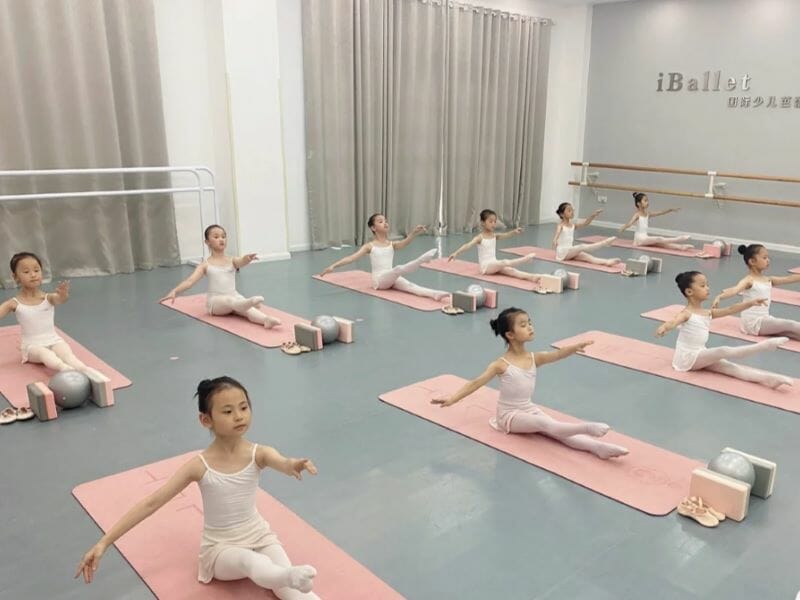There are lots of rumors surrounding different activities stunting growth in children. Parents are often concerned that ballet will stunt the growth of their children, especially if they are training in a pre-professional program.
Despite some claims, scientific studies have shown that ballet is not linked with significantly stunted or delayed growth in children. However, there is some correlation between delayed puberty and growth patterns with ballet culture.
While there is no evidence that ballet stunts growth, there are still many valid concerns about bone density, weight, and overall health of young dancers. This can result in some growth differences between dancers and their non-dancing peers.

Does Ballet Stunt Growth?
There have been many claims, often by legitimate sources, that ballet stunts growth. This came from the concerns surrounding gymnastics and other sports stunting or delaying growth in children. However, a study published in 2006 came to the conclusion that “moderate-high levels of dance training do not affect linear growth and maturation.”
The previous claims weren’t entirely false, though. While ballet training doesn’t stunt growth, the habits of dancers, pushed on them by teachers, peers, and even themselves, can interfere with puberty and growth. Young dancers exercise many hours a day and eat very little trying to stay as thin as possible.
These habits can lead to a lower bone density in young dancers and other health concerns related to being underweight. This can result in a shorter stature, especially during puberty. These dancers may have a delayed growth pattern.
Not only can these habits result in delayed growth, they can also impact puberty. Many studies and surveys have shown that puberty occurs later in girls who are involved with high levels of ballet training.
How Does Ballet Impact Height?
Professional female ballet dancers average around 5’5’’ or 167cm. The average height of a female in the United States is 5’4’’ or 162cm. This proves that the end height of ballet dancers isn’t any shorter than average.
While dancing doesn’t impact end height, it’s effects on dancers’ habits can affect their growth patterns. This means that young dancers might feel like they are too short and feel inadequate compared to the taller dancers that they see on social media or dancing in their local ballet company.
However, this does bring up another important discussion: height discrimination. Many ballet companies will only take dancers of a certain height, usually around the 5’5’’. This means that dancers that are too short or too tall either can’t get a job or simply give up because they assume nobody will hire them.
This leads to even more body image issues that can lead to more unhealthy habits, which can in turn impact growth. It’s a vicious circle that dancers have to navigate at quite a young age.
Read more: Ballet Dancers Average Height: 11 Examples Female & Male
Why Doesn’t Ballet Stunt Growth?
Some activities are commonly associated with stunted growth, such as artistic gymnastics. This is largely due to the stress put on the growth plates in a growing child. This stress can be caused by injuries, repetitive impact, and overuse.
Stress placed on growth plates and bones can delay growth in extreme cases. However, this isn’t always the case. Many times the growth and puberty delays are caused by undereating and over-exercising, just like ballet.
Dancers injure themselves more often than the average child, so there can be a slight increase of stress on growth plates. However, ballet doesn’t put nearly as much stress on growth plates and bones as other sports and activities do. Nutritional habits are still the primary culprit in any delays in puberty.
Health Concerns in Young Dancers
Ballet training can be really good for you. It keeps you active and at your peak athletically. However, many young dancers are encouraged to eat less to maintain their ‘perfect ballet bodies.’
This is a huge concern since caloric intake is important for the growing dancer. Lower caloric intake leads to decreased bone density, vitamin and mineral deficiencies, and menstrual concerns in females.
Low bone density can often lead to osteoporosis in female dancers as well as athletes across the board. Osteoporosis can be especially dangerous in dancers (and other athletes). Constant impact on the bones makes them more susceptible to injury.
Reduced caloric intake can also lead to fatigue, dwindling mental health, and multitudes of other health concerns, especially during puberty. Proper nutrition is imperative to a healthy young dancer.
While there are many concerns surrounding health and growth in ballet dancers, the benefits can’t be overlooked. Vigorous ballet training is good for young dancers’ physical health by keeping them active. It can also teach them to take their craft seriously and develop a good work ethic.
Ballet and Body Image
Ballet doesn’t directly cause health issues, but the pressures put on dancers to look a certain way leads to many health concerns. This pressure comes from teachers, peers, social media, and even the dancer themself.
Dancers are constantly being scrutinized for how they look. There are some studios and conservatories that promote positive body image concepts. However, this isn’t true for many studios and conservatories.
Some studios have toxic standards for weight. This leads dancers to eat less and less, which can lead to different growth and health issues. Mental health can often be poor in dancers in these scenarios.
Outside of toxic conservatories and studios, social media can be a source of body image struggles in dancers. The constant exposure to ballet dancers that look ‘perfect’ can lead to body image issues which eventually can cause eating disorders.
Preventing Health and Growth Issues in Dancers
Health and growth issues are unfortunately a reality in many ballet dancers, due to body image struggles and pressures put on young dancers to perform at their highest level. There are a couple of different ways that studios, teachers, parents, and peers can help keep dancers physically and mentally healthy.
Encouraging dancers to maintain a healthy diet is paramount. Adhering to a proper caloric intake will help dancers keep a healthy weight. This will prevent growth and puberty delays along with better bone density and proper mineral levels.
Body image is an important factor to consider when trying to prevent growth and health issues in dancers. Dancers that feel pressure to look a certain way are much more likely to develop an eating disorder and in turn stunt their growth or develop osteoporosis.
Maintaining a positive body image culture in the studio and home is one of the best ways to keep young dancers healthy physically and mentally. Making dancers feel good about a healthy weight will encourage them to start or continue eating properly.
Things to Remember
There are many concerns surrounding ballet and stunted growth and puberty, health issues from undereating, and body image struggles. There are a few important things to remember about ballet, growth, and health:
- Ballet itself is very good for your health. It keeps your body in peak condition by encouraging dancers to maintain good exercise and stretching routines.
- The culture surrounding ballet can sometimes lead to body image issues and/or eating disorders. Decreased caloric intake can cause the growth and puberty delays that are sometimes associated with young dancers.
- Disordered eating and body image issues also cause lower bone density and osteoporosis. This increases the risk and severity of injuries in these young dancers.
- Height discrimination is a major issue in the ballet world. This can result in even more body image issues in young dancers, especially those who are experiencing delayed growth patterns.
- Many other health issues can arise from under-eating and over-exercising. Over time, this can result in unhealthy young dancers, both male and female.
- Preventing growth delays and negative health impacts is important in all ballet dancers, especially in their early years. The best way to go about this is by creating a positive and balanced culture surrounding body image and health in ballet conservatories and studios.
Remember, ballet is beautiful, fun, and a great source of exercise. Taking care of your body physically and mentally is important in any activity or career. Ballet doesn’t pose any more risk to your health or growth than any other activity. Don’t let anyone stop you from dancing as much as you want.
Read more:




